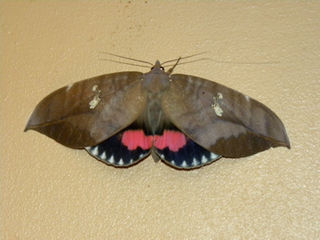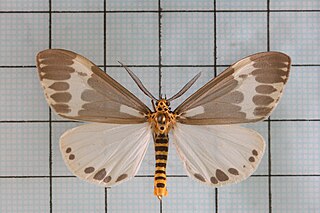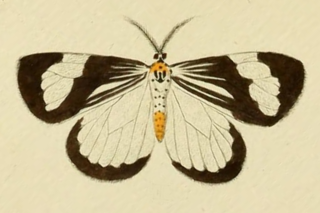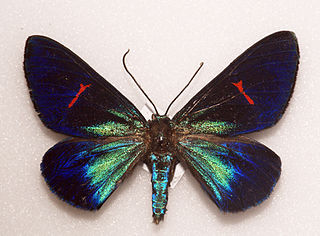
Pieter van Vollenhoven Jr. is the husband of Princess Margriet of the Netherlands and a member, by marriage, of the Dutch Royal House.

Attevidae is a family of moths of the Yponomeutoidea superfamily, containing only one genus, Atteva. The group has a pantropical distribution, but at least one species has a range that extends into the temperate zone. No consistent hypotheses regarding the relationships, placement, and ranking of Attevidae have been published, but the prevalent view is that they likely form a monophyletic group within the Yponomeutoidea.

Phyllodes are modified petioles or leaf stems, which are leaf-like in appearance and function. In some plants, these become flattened and widened, while the leaf itself becomes reduced or vanishes altogether. Thus the phyllode comes to serve the purpose of the leaf. Some important examples are euphorbia roylena which are cylinderical and optunia which are flattened.

In botany, the petiole is the stalk that attaches the leaf blade to the stem, and is able to twist the leaf to face the sun. This gives a characteristic foliage arrangement to the plant. Outgrowths appearing on each side of the petiole in some species are called stipules. Leaves lacking a petiole are called sessile or apetiolate.

The Calpinae are a subfamily of moths in the family Erebidae described by Jean Baptiste Boisduval in 1840. This subfamily includes many species of moths that have a pointed and barbed proboscis adapted to piercing the skins of fruit to feed on juice, and in the case of the several Calyptra species of vampire moths, to piercing the skins of mammals to feed on blood. The subfamily contains some large moths with wingspans longer than 5 cm (2 in).

Phyllodes is a genus of moths in the family Erebidae. The genus was erected by Jean Baptiste Boisduval in 1832

Phyllodes imperialis, the imperial fruit-sucking moth or pink underwing moth, is a noctuoid moth in the family Erebidae, subfamily Calpinae. It was first described by Herbert Druce in 1888. The species can be found in north-eastern Queensland to northern New South Wales, Papua New Guinea, Solomons, Vanuatu and New Caledonia.

Phyllodes verhuelli is a noctuoid moth in the family Erebidae, subfamily Calpinae first described by Samuel Constantinus Snellen van Vollenhoven in 1858. The species can be found in lowland forests in Sundaland, southern Myanmar and the Philippines.

Phyllodes consobrina is a noctuoid moth in the family Erebidae and subfamily Calpinae. It was first described by John O. Westwood in 1848. The species can be found in Asia, including Thailand, Sri Lanka, Bangladesh, the Andamans and India.
Asota orbona is a moth of the family Erebidae first described by Samuel Constantinus Snellen van Vollenhoven in 1863. It is found in Indonesia, Papua New Guinea and Queensland.

Stigmella zelleriella is a moth of the family Nepticulidae found in Europe and Russia. It was first described by Samuel Constantinus Snellen van Vollenhoven in 1875. The name zelleriella, honours the German microlepidopterist Philipp Christoph Zeller.

Nyctemera arctata is a moth of the family Erebidae. It is found in India, China, Nepal, Bhutan, Myanmar, the Philippines, Taiwan and Indonesia. The species was described by Francis Walker in 1856.

Nyctemera luctuosa is a moth of the family Erebidae first described by Samuel Constantinus Snellen van Vollenhoven in 1863. It is found in Papua New Guinea, Australia and the Philippines. The habitat consists of mountainous areas.
Nyctemera ludekingii is a moth of the family Erebidae first described by Vollenhoven in 1863. It is found on Sumatra and Borneo.

Nyctemera tripunctaria is a moth of the family Erebidae first described by Carl Linnaeus in his 1758 10th edition of Systema Naturae. It is found in southern China, Cambodia, Thailand, Vietnam, Sundaland, the Philippines and on Sulawesi.
Enoplidia simplex is a moth in the family Oecophoridae. It was described by Turner in 1896. It is found in Australia, where it has been recorded from Queensland, New South Wales and Victoria.

Milionia fulgida is a species of day-flying moth in the family Geometridae. The species was first described by Vollenhoven in 1863. It is found on Java and Borneo. Adults are distinguished by the lack of any orange marking on the hindwings.














